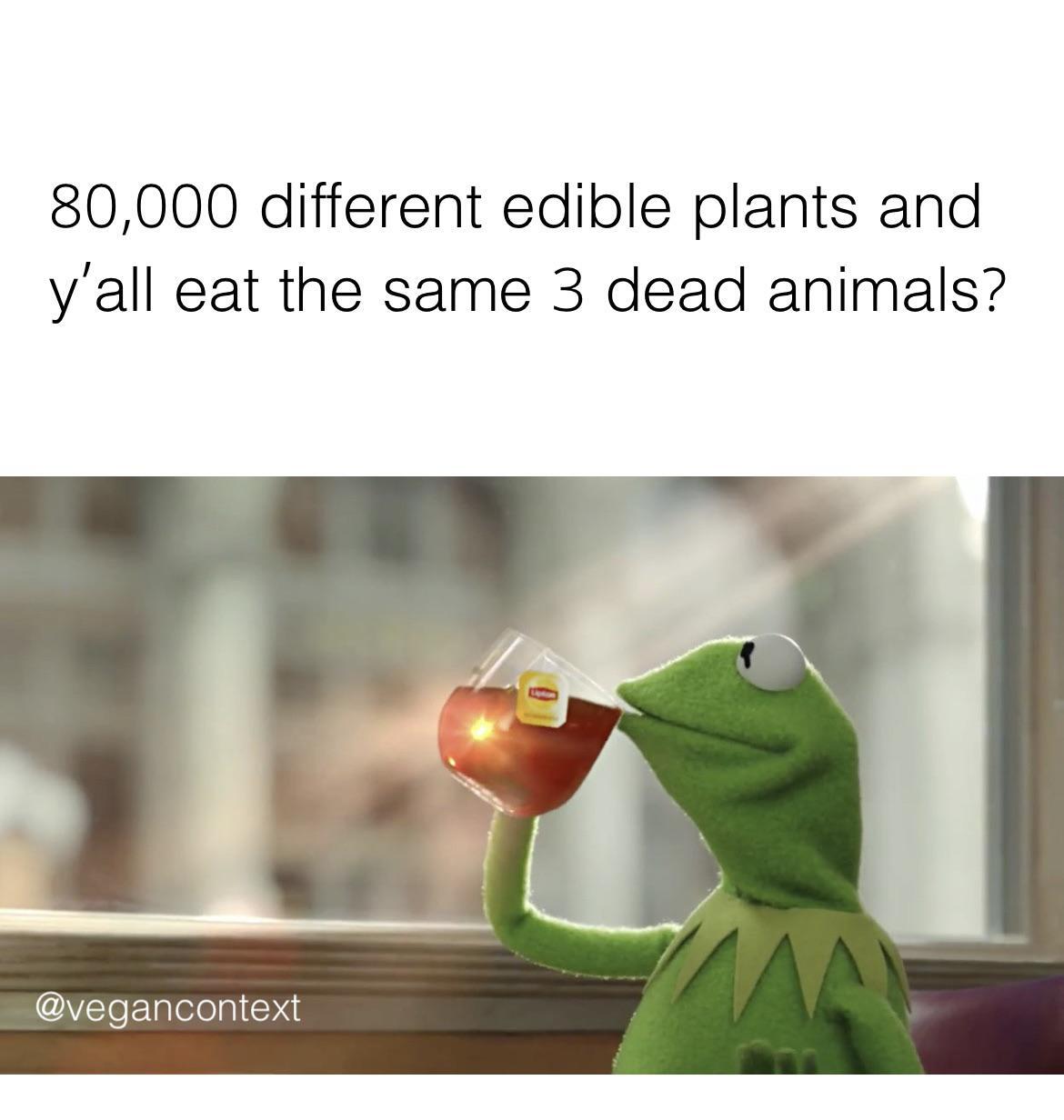this post was submitted on 18 Jul 2023
556 points (76.1% liked)
Memes
45728 readers
751 users here now
Rules:
- Be civil and nice.
- Try not to excessively repost, as a rule of thumb, wait at least 2 months to do it if you have to.
founded 5 years ago
MODERATORS
you are viewing a single comment's thread
view the rest of the comments
view the rest of the comments

"You ever plow a field? To plant the quinoa or sorghum or whatever the hell it is you eat. You kill everything on the ground and under it.
You kill every snake, every frog, every mouse, mole, vole, worm, quail… you kill them all.
So, I guess the only real question is: how cute does an animal have to be before you care if it dies to feed you?”
-John Dutton
Cows and chickens gotta eat too, and that food is coming from fields as well.
By reducing meat consumption also way less critters will end up dying.
I'm not here to reduce my meat consumption. It's at the perfect level.
You're free to do whatever you want, all I meant is decreasing meat consumption not only will reduce the amount of big animals killed, but also the number of smaller ones. Growing a cow takes a whole lot of grain.
Are you from a farm town?
A supermajority of animal feed comes from the waste product of crops we that were being grown anyway, or grass from a fallow field that needs to be harvested anyway (not enough the latter due to logistics, but my local farms all do). That whole "8 to 1" calorie to cow thing leaves out the part that it's 8 calories of landfill material to make 1 calorie of beef. Nobody has an "animal only" corn field. And nobody is using harsh animal-killing chemicals on the fallow fields.
And cows are still being fed things whether you eat them or not. We need their manure and it's overall better for the environment than synthetic fertilizer. Without some form of fertilizer, we need much more farmland, which means more animals killed per calorie. All compared to 700,000 calories in a cow.
Unfortunately, nobody has ever demonstrated in a defensible manner that a horticulture-only scenario would be anywhere near as efficient on animal lives as what we have now. It's one thing to cut animal intake 10%, entirely another to try to rebuild our farming industry without animals.
According to the Alberta Cattle Feeders Association, 80% of the feed is composed of corn. According to the USDA itself half the corn grown in the US was used for animal feed, and 78% of the world's soy production is made for animal feed.
Is the waste product of corn and soy included in these numbers?
The ACFA link you sent doesn't seem to say what you referenced, that I could find. In fact, I've never seen anyone say that cattle is fed decent corn in any stage of life except "finishing" (which reduced gaminess), and even then 80% is the high end.
A more accurate number is that 86% of a an animal's diet is human-inedible (see below), roughages and byproducts. That number CAN easily be moved closer to 100% at the cost of gaminess, but I have had beef that was not "finished" and it was ok. I'm definitely ok sacrificing a little corn to get the improved flavor.
Note the 86%? That's animals in general. If you focus on cows, that number crosses to 90%. And if we're talking all non-vegan products, MILK (for those not allergic to it like myself) is incredibly nitritious compared to the total potential human nutritional value of a dairy cow's intake.
Since I cannot seem to trace your references, I'm not sure. But it's covered in the numbers I linked. Every single reputable or researched reference I have ever seen on the topic (as well as the actual cattle ranches I've lived near) put a bare minimum of 85% of a cow's diet as inedibles. And why would it be anything else? Those inedibles are dramatically cheaper than buying edible corn.
...and stepping back, I'd like to point out that we're discussing the paltry percent of some of the least nutritionally valuable crops in the world are eaten by cows, who by any honest analysis produces one of the most nutrious staple foods known to man.
The figure was almost by the middle of the page, search for the string "AT THE FEEDLOT, CATTLE ARE FED A DIET OF 80% GRAIN AND 20% FORAGES. (SILAGE AND HAY)", on the section "Start weight, finish weight".
As for the others:
Here's the USDA source: https://www.ers.usda.gov/topics/crops/corn-and-other-feed-grains/feed-grains-sector-at-a-glance/:
And regarding soy, here's from the WWF: https://wwf.panda.org/discover/our_focus/food_practice/sustainable_production/soy/
You obviously know way more than me about the subject but you gotta excuse me for taking anything from a website called "sacredcow" talking about the "plant-based industry" at the top of the page with a grain of salt, everything else I've seen online points to animal farming being incredible inefficient and a huge contributor to global warming and water waste.